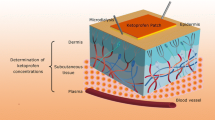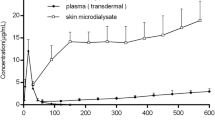Abstract
Purpose. To characterize the enantiomers of oxybutynin (OXY) and N-desethyloxybutynin (DEO) following transdermal and oral administration.
Methods. OXY was administered either as a single transdermal system over a 96 h wear period or as a single 5 mg immediate-release tablet to 18 healthy male and female subjects in a randomized, open-label, two-way crossover design. Blood samples were collected for 108 h after application of the transdermal system and for 6 h after oral administration. Plasma concentrations of the R- and S-enantiomers of OXY and DEO were assayed by LC-MS/MS. Enantiomer in vitro skin flux was evaluated using human cadaver skin.
Results. In vitro skin flux studies demonstrated equal absorption of R and S- OXY. Plasma concentrations and pharmacokinetic parameters of the R-enantiomers of OXY and DEO were slightly lower than the S-enantiomers following transdermal OXY. The relative AUC values were S-OXY>S-DEO>R-OXY>R-DEO. The AUC ratios of DEO/OXY were less than 1 for both the R- and S- enantiomers. Following oral dosing, plasma DEO concentrations greatly exceeded OXY resulting in relative AUC values of R-DEO>S-DEO>S-OXY>R-OXY. The mean AUC ratios of S- and R-DEO/OXY were 3.25 and 8.93, respectively.
Conclusions. Stereoselective metabolism of OXY was evident following both transdermal and oral administration of OXY. The reduced pre-systemic metabolism of transdermally administered OXY compared to oral administration resulted in not only significantly lower DEO plasma concentrations, but also a different metabolite pattern. The differences between R-OXY and R-DEO following the two routes of administration support the potential for comparable clinical efficacy and reduced anticholinergic side-effects with transdermal treatment.
Similar content being viewed by others
REFERENCES
D. M. Holmes, F. J. Montz, and S. L. Stanton. Oxybutynin verses propantheline in the management of detrusor instability. A patient-regulated variable dose trial. Br. J. Obstet. Gynaecol. 96:607-612 (1989).
A. J. S. Tapp, L. D. Cardozo, E. Versi, and D. Cooper. The treatment of detrusor instability in postmenopausal women with oxybutynin chloride: a double blind placebo controlled study. Br. J. Obstet. Gynaecol. 97:521-526 (1990).
J. W. Thüroff, B. Bunke, A. Ebner, P. Faber, P. de Geeter, J. Hannappel, H. Heidler, H. Madersbacher, H. Melchior, W. Schäfer, T. Schwenzer, and M Stöckle. Randomized, double-blind, multicenter trial on treatment of frequency, urgency and incontinence related to detrusor hyperactivity: Oxybutynin verses propantheline verses placebo. J. Urol. 145:813-817 (1991).
P. M. Lish, J. A. Labudde, E. L. Peters, and S. I. Robbins. Oxybutynin—A musculotropic antispasmodic drug with moderate anticholinergic action. Arch. Int. Pharmacodyn. Ther. 156:467-488 (1965).
L. Noronha-Blob, V. C. Lowe, J. S. Peterson, and R. C. Hanson. The anticholinergic activity of agents indicated for urinary incontinence is an important property for effective control of bladder dysfunction. J. Pharmacol. Exp. Ther. 251:586-593 (1989).
L. Noronha-Blob and J.F. Kachur. Enantiomers of oxybutynin: In vitro pharmacological characterization at M1, M2 and M3 muscarinic receptors and in vivo effects on urinary bladder contraction, mydriasis and salivary secretion in guinea pigs. J. Pharmacol. Exp. Ther. 256:562-567 (1991).
J. F. Kachur, J. S. Peterson, J. P. Carter, W. J. Rzeszotarski, R. C. Hanson, and L. Noronha-Blob. R and S enantiomers of oxybutynin: Pharmacological effects in guinea pig bladder and intestine. J. Pharmacol. Exp. Ther. 247:867-872 (1988).
J. Douchamps, F. Derenne, A. Stockis, D. Gangji, M. Juvent, and A. Herchuelz. The pharmacokinetics of oxybutynin in man. Eur. J. Clin. Pharmacol. 35:515-520 (1988).
K. M. Hughes, J. C. T. Lang, R. Lazare, D. Gordon, S. L. Stanton, J. Malone-Lee, and M. Geraint. Measurement of oxybutynin and its N-desethyl metabolite in plasma, and its application to pharmacokinetic studies in young, elderly and frail elderly volunteers. Xenobiotica 7:859-869 (1992).
H. Madersbacher and G. Jilig. Control of detrusor hyperreflexia by the intravesical instillation of oxybutynin hydrochloride. Paraplegia 29:84-90 (1991).
C. U. Moisey, T. P. Stephenson, and C. B. Brendler. The urodynamic and subjective results of treatment of detrusor instability with oxybutynin chloride. Br. J. Urol. 52:472-475 (1980).
C. A. Massad, B. A. Kogan, and F. E. Trigo-Rocha. The pharmacokinetics of intravesical and oral oxybutynin chloride. J. Urol. 148:595-597 (1992).
E. W. Merritt and E. R Cooper. Diffusion apparatus for skin permeation. J. Cont. Rel. 1:161-162 (1984).
A. M. Kligman and E. Christophers. Preparation of isolated sheets of human stratum corneum. Arch. Dermatol. 88:702-705 (1963).
M. Gibaldi and D. Perrier. Pharmacokinetics: Second Edition, Revised and Expanded, Marcel Dekker, Inc. NY, 1982 pp. 445-448.
E. R. Smith, S. E. Wright, G. Aberg, Y. Fang and J. R. McCullough. Comparison of the antimuscarinic and antispasmodic actions of racemic oxybutynin and desethyloxybutynin and their enantiomers with those of racemic terodiline. Arzneim.-Forsch./Drug Res. 48:1012-1018 (1998).
D. W. Boulton and J. P Fawcett. Enantioselective disposition of salbutamol in man following oral and intravenous administration. Br. J. Clin. Pharmacol. 41:35-40 (1996).
P. A. Soons and D. D. Breimer. Stereoselective pharmacokinetics of oral and intravenous nitrendipine in healthy male subjects. Br. J. Clin. Pharmacol. 32:11-16 (1991).
A. Volosov, S. Xiaodong, E. Perucca, B. Yagen, A. Sintov, and M. Bialer. Enantioselective pharmacokinetics of 10-hydroxycarbazepine after oral administration of oxycarbazepine to healthy Chinese subjects. Clin. Pharmacol. Ther. 66:547-553 (1999).
J. Kao and M. P. Carver. Cutaneous metabolism of xenobiotics. Drug Metab. Reviews 22:363-410 (1990).
H. Mukhtar and W. A. Khan. Cutaneous cytochrome P-450. Drug Metab. Reviews 20:657-673 (1989).
G. Buyse, K. Waldeck, C. Verpoorten, H. Björk, P. Casaer, and K. E. Andersson. Intravesical oxybutynin for neurogenic bladder dysfunction: less systemic side effects due to reduced first pass metabolism. J. Urol. 160:892-896 (1998).
K. Waldeck, B. Larsson, and K-E. Andersson. Comparison of oxybutynin and its active metabolite, N-desethyl-oxybutynin, in the human detrusor and parotid gland. J. Urol. 157:1093-1097 (1997).
Author information
Authors and Affiliations
Rights and permissions
About this article
Cite this article
Zobrist, R.H., Schmid, B., Feick, A. et al. Pharmacokinetics of the R- and S-Enantiomers of Oxybutynin and N-Desethyloxybutynin Following Oral and Transdermal Administration of the Racemate in Healthy Volunteers. Pharm Res 18, 1029–1034 (2001). https://doi.org/10.1023/A:1010956832113
Issue Date:
DOI: https://doi.org/10.1023/A:1010956832113




